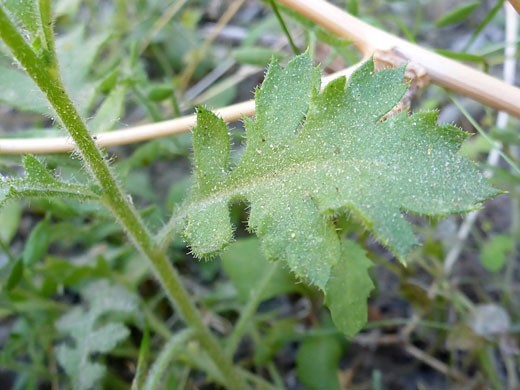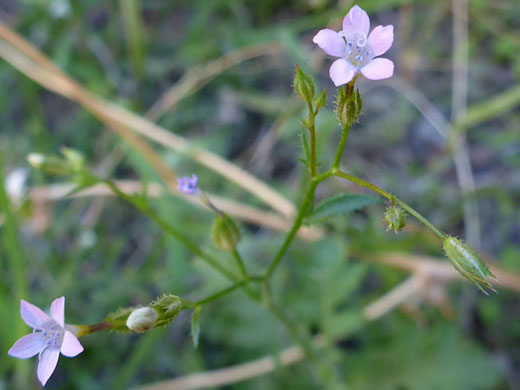
Pale pink flowers with green calyces; gilia scopulorum, Titus Canyon, Death Valley National Park, California
Common name:
Rock gilia
Family:
Scientific name:
Gilia scopulorum
Main flower color:
Range:
The Mojave Desert, and some adjoining areas
Height:
Up to 12 inches
Habitat:
Rocky places, usually in canyons, from near sea level to 5,000 feet
Leaves:
Up to 2 inches long, divided once or twice into irregular lobes
Season:
April to May
Leaves of gilia scopulorum are somewhat wider than many other gilia species, irregularly divided into broad lobes, themselves partly lobed, or toothed. Lobe tips taper to a sharp point. The undersurfaces of the leaves have a covering of translucent, glandular hairs. Lower stem leaves are angled upwards, and form a rosette; upper leaves are smaller, less divided and few in number. Stems are erect, branched and glandular hairy.
The inflorescence is an open cluster, typically of around 20 flowers, attached by pedicels of differing lengths. Pedicels and calyces are covered by stalked, glandular hairs. The calyces, less than 0.2 inches long, have five green lobes, tapering to a sharp point, separated by narrower white margins. The corolla, up to 0.7 inches in length, has a narrow purple tube, a gradually widening throat, yellow to pink, and five pale, lavender-pink lobes, blunt-pointed at the tips. The five stamens have white filaments and blue anthers, and, like the style, are exserted a little way beyond the corolla lobes.
The inflorescence is an open cluster, typically of around 20 flowers, attached by pedicels of differing lengths. Pedicels and calyces are covered by stalked, glandular hairs. The calyces, less than 0.2 inches long, have five green lobes, tapering to a sharp point, separated by narrower white margins. The corolla, up to 0.7 inches in length, has a narrow purple tube, a gradually widening throat, yellow to pink, and five pale, lavender-pink lobes, blunt-pointed at the tips. The five stamens have white filaments and blue anthers, and, like the style, are exserted a little way beyond the corolla lobes.
All Contents © Copyright The American Southwest | Comments and Questions | Contribute | Site Map



